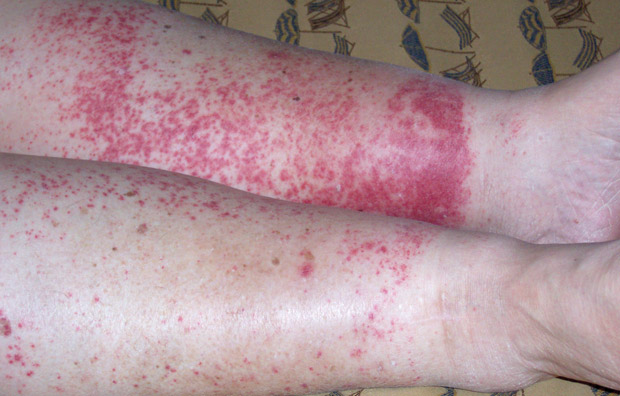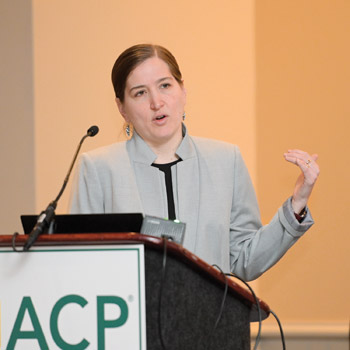MKSAP Quiz: Joint pain, rash, and weakness
A 61-year-old woman is evaluated for joint pain, a rash on her legs, and weakness. She has chronic genotype 1 hepatitis C viral infection. She takes no medication.

On physical examination, vital signs are normal. The lower extremities are shown. No evidence of muscle weakness, joint swelling or warmth is noted on musculoskeletal exam. The liver edge is palpable at the costal margin. The remainder of the physical examination is unremarkable.
Laboratory studies:
| Complete blood count | Normal |
| Alanine aminotransferase | 112 U/L |
| Aspartate aminotransferase | 84 U/L |
| Total bilirubin | 1 mg/dL (17.1 µmol/L) |
| Creatinine | Normal |
| Urinalysis | Normal |
Which of the following is the most appropriate treatment?
A. Cyclophosphamide
B. Glucocorticoids
C. Ledipasvir and sofosbuvir
D. Pegylated interferon and ribavirin
E. Rituximab
Answer and critique
The correct answer is C. Ledipasvir and sofosbuvir. This item is Question 87 in MKSAP 18's Gastroenterology and Hepatology section.
A combination of ledipasvir and sofosbuvir is the most appropriate treatment for this patient. The patient has Meltzer triad—consisting of asthenia, arthralgia, and palpable purpura—which is the classic presentation of type II mixed cryoglobulinemia, a vasculitis that most often arises in the context of chronic hepatitis C virus (HCV) infection. Meltzer triad is seen in less than 30% of patients, but nearly all patients with type II cryoglobulinemia develop cutaneous findings, as seen in this patient. Other findings may include peripheral neuropathy; membranoproliferative glomerulonephritis; and pulmonary, central nervous system, or gastrointestinal vasculitis. Urinalysis may show dysmorphic erythrocytes and proteinuria, which are features of glomerulonephritis, but this patient shows no evidence of kidney involvement or other end-organ damage. The best initial treatment for a mild presentation of mixed cryoglobulinemia arising from chronic HCV infection is to treat and eradicate HCV with sofosbuvir-ledipasvir. Other direct-acting antiviral agents that could be used interchangeably to treat genotype 1 HCV include grazoprevir-elbasvir; paritaprevir-ritonavir, ombitasvir, and dasabuvir; glecaprevir-pibrentasvir; sofosbuvir-daclatasvir; and sofosbuvir-velpatasvir. It is expected that other combinations of direct-acting antivirals will be developed. Treatment of HCV infection with direct-acting antiviral combinations results in a sustained virologic response (cure) in more than 90% of patients, even in those who were previously and unsuccessfully treated with pegylated interferon and ribavirin. In approximately 90% of cases, eradication of HCV leads to resolution of the mixed cryoglobulinemia.
Most of the data pertaining to the treatment of HCV infection in patients with mixed cryoglobulinemia involve treatment with pegylated interferon and ribavirin. However, pegylated interferon and ribavirin are no longer recommended for treatment of HCV infection due to adverse effects and lower efficacy compared to interferon-free, direct-acting antiviral therapy.
For severe end-organ damage from mixed cryoglobulinemia, including kidney failure, gastrointestinal vasculitis, rapidly progressive neuropathy, pulmonary or central nervous system vasculitis, or heart failure, rituximab is a first-line agent and may be used with pulse-dose glucocorticoids. However, this patient has mild manifestations of mixed cryoglobulinemia and, therefore, does not require immunosuppressive therapy with rituximab, cyclophosphamide, or glucocorticoids.
Key Point
- Mixed cryoglobulinemia arising from chronic hepatitis C viral infection resolves after treatment and eradication of the virus.




